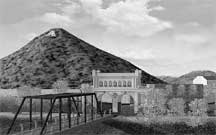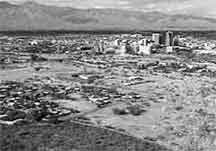
By Ray Murray and Daniel Samorano
The Rio Nuevo Project, approved by Tucson voters in 1999, is one of the significant turning points in Tucson's history and a defining milestone pointing toward its future. Construction of museums and commercial and residential facilities is the "heart" of the project. However, 50 acres of the Rio Nuevo Project site consist of old closed landfills. Because of known problems associated with old landfills, it was clear that a creative approach was needed to restore the land to beneficial use.
The city of Tucson conducted a pilot Landfill Stabilization Project (LSP) on the Nearmont Landfill within the Rio Nuevo Project site. The LSP uses enhanced aerobic degradation methods to accelerate the natural decomposition process, thereby stabilizing the refuse contained in the landfills much faster than would occur under anaerobic conditions.
Water is applied to the surface of the test site to increase
the moisture content of buried refuse. Ground penetrating radar is used to measure
water infiltration into the refuse and to monitor the moisture content. Air
is injected into the landfill through vertical wells and controlled by a series
of extraction wells. The entire project site is monitored continuously for methane,
carbon dioxide, oxygen levels and temperature changes.

Planned
bridge reconstruction,
Rio Nuevo Project

View
of Rio Nuevo
Project Site from "A" Mountain
Initial results from the LSP technology show:
The signs of aerobic degradation include elevated temperatures, increased settlement, extremely low levels of methane, and increased production of carbon dioxide. More than 46% of the organic material within the site has been degraded during the first three months of air circulation and water application. More than one foot of surface settlement has been measured in the same period. Based on the preliminary data, the landfill could be effectively degraded within two years.
Because of the promising results, the city of Tucson now will apply the technology to a second, larger site, known as the Congress Landfill. At the Congress site, the well spacing will be increased, injected air will be cycled to control temperatures more effectively, and reclaimed water will become the water source.
The city of Tucson believes that the technology being tested will prove the pilot program's goals: to create a method for accelerating landfill cleanup and stabilization at minimal costs, within a much shorter time frame than conventional methods require, while addressing the health and safety concerns voiced by neighborhood residents. This innovative technology promises not only to lay a solid foundation for the planned $300 million Rio Nuevo Project, but also to provide Tucson with an economical, fast and environmentally desirable way to restore old landfills for the benefit of the public.
For further information about this project, please contact the authors at the City of Tucson, Office of Environmental Management, 201 N. Stone, Tucson, AZ 85726, (520) 791-5414.
© City
of Phoenix Brownfields Land Recycling Program
Originally printed in the June 2002 Issue of "Brownfields
Bulletin."
Back
to HGC's Landfill Services Page